Weaving and textiles have always been associated with women throughout the centuries. There is a folk song, The Ballad of Mulan, that talks about “Mulan weaving in front of the doorway.” In Chinese mythology, the seventh daughter of the Jade Emperor falling in love with a human being is a weaving girl in heaven, also symbolizing the second brightest star in the northern hemisphere, Vega. As most people remember, a woman has mastered the skill of weaving, which can transform textile materials into different knitted fabrics with her hands. If she moves forward in the field of art, these materials that naturally fall into her vision will become a medium for her to explore macro issues such as herself, life, society, and nature. Despite being rejected by Western art, textiles have entered the art canon--no longer limited to gender--thanks to the movement of female pioneers. Enter the work of Japanese artist Chiharu Shiota, where yarn threads constitute unparalleled significance, implicating her inescapable memories and emotions via constant twisting and weaving. The employ of different fiber materials can be seen in the works of many artists such as Magdalena Abakanowicz, the Polish artist who inspired Shiota, and Cecilia Vicu?a, the Chilean artist who won the Golden Lions for Lifetime Achievement at the 59th Venice Biennale.
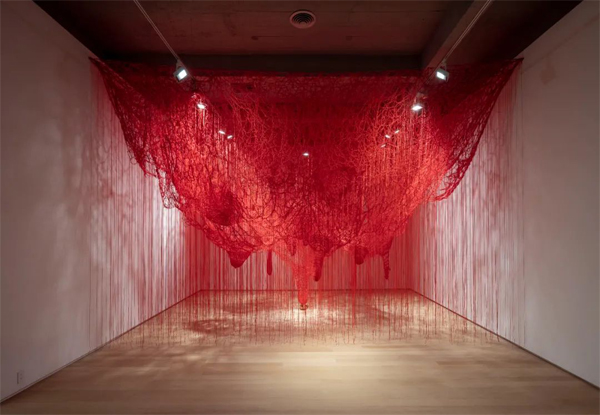
Installation shot of Signs of Life, Templon Gallery, New York. Photo: Charles Roussel. Courtesy of Templon Gallery and the artist
Shiota studied oil painting at Kyoto Seika University, Japan in 1992, and began creating other art forms in the following years, of which her large-scale immersive installations are the most famous and widely recognized. There is no doubt that the creative environment of being in the “web” is completely distinct from the two-dimensional plane, and it is a kind of “drawing in the air” feeling. But the dots, lines, and surfaces that form the picture on paper can also be applied to Shiota’s installations: the lines nailed to the floor and walls form the dots, and different lines are tangled and crocheted into irregular blocks to create space. The magnitude and tediousness of the project are astonishing, and it also portrays the endurance, determination, imagination, and practical ability of women, no less than the meticulousness of painting.
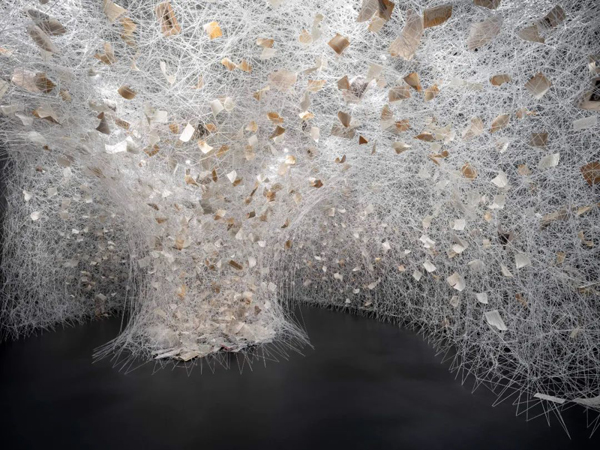
Installation shot of Signs of Life, Templon Gallery, New York. Photo: Charles Roussel. Courtesy of Templon Gallery and the artist
In Signs of Life at Galerie Templon, New York, the white yarn threads nailed on the floor are like the tentacles of a creeper, climbing constantly and covering the entire gallery space to produce the installation Connected to the Universe (2023). One walks through the space and contemplates the artist’s thoughts as if taking a flatboat to enjoy a cavernous landscape. Those prints of the book, written in German, are placed in the yarn to create a “formalin” type of freshness and freezing effect, which makes one stop for a moment and reveals the marks of Shiota’s life. In contrast to blank paper entwined in other pieces, those printed sheets tell us that Berlin is her other home. Here she met her lover, had a family, and now lives and works in the city. Family is very meaningful to her. This is a warm and deeply personal emotion that is another fuel for her art, as in the sculptures she makes using her family’s hands as models.
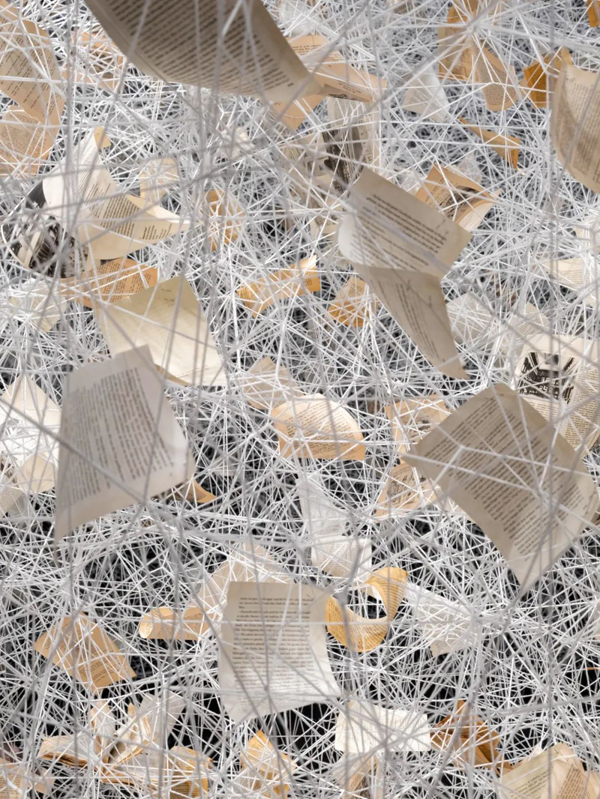
Installation shot of Signs of Life, Templon Gallery, New York. Photo: Charles Roussel. Courtesy of Templon Gallery and the artist
According to the gallery space and the structure of the work, Shiota took two weeks to complete The Web Above Our Live (2023). Numerous yarn threads cascade from the ceiling around several knitted fabrics of varying heights and interconnected--resembling nets and suggesting feminine characteristics. The bronze hands are placed in the center, slightly open in the form of support, to catch one of the longest pieces of knitted fabric falling from the ceiling. The intricate yarn threads form an intricate web connecting diverse civilizations and regions. One is reminded of the rituals and scenes in East Asian religions where witch gods liberate certain beings or communicate with spirits in the sky with specific objects. As the red yarn threads and the hands react, they convey a message: the body, although material, will disappear with death, but the spirit will remain. With the increasing growth of the Shinto belief system, Shiota’s works are endowed with invisible energy and magic. The emphasis on personal emotions allows her to convey inner experiences, such as fear, a necessary emotion that makes art for her, to the public veraciously. The black yarn threads wrapped around the white dress create a striking black-and-white visual, like silent images. An eerie vision produces a psychological atmosphere similar to that of Japanese horror films, which reaches the heart. This evokes a certain perception that sways between fear and non-fear. The black threads are also akin to mist, blurring the exact appearance of the white dress and giving it a pure and divine aura--it looks so flawless--revealing a woman bound to a fate but possessing the power to break free. Like other items, the dress was collected by Shiota from other places. These human remnants are what she calls “third skin.” They continue Shiota’s concept of “existence in the absence” and speak to the idea of “living with their bodies as their only real possession.”
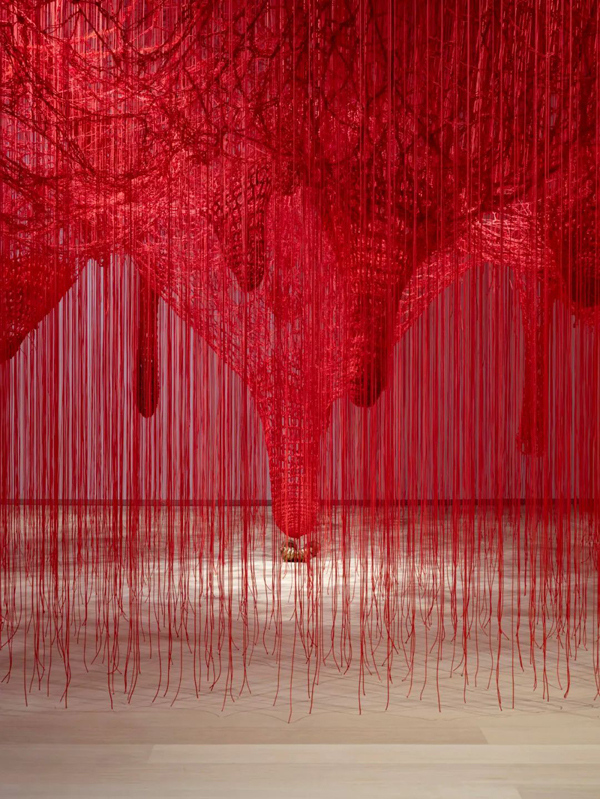
Installation shot of Signs of Life, Templon Gallery, New York. Photo: Charles Roussel. Courtesy of Templon Gallery and the artist
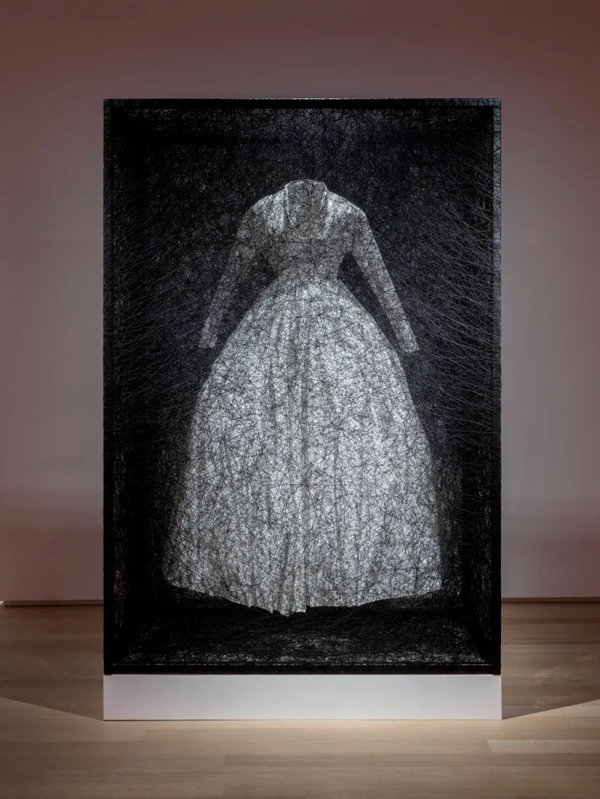
Installation shot of Signs of Life, Templon Gallery, New York. Photo: Charles Roussel. Courtesy of Templon Gallery and the artist
Shiota expressed that white is the embodiment of purity, which in Japan is also related to death, while black is the night or the universe. Red has an ineffable visual power, which, for her, means blood, the body, and human relationships. Red-related objects like pigment, red liquid, and red meat are also consistently favored by varying artists. Chinese performance artist Zhang Huan, for instance, dresses in a suit with raw meat. Abstract painter Mark Rothko draws with large areas of red. And in Shiota’s early performance video, Becoming Painting (1994), red is already visible, in which she sprinkled red enamel paint all over her body and then merged it with herself. In Earth and Blood (2013), she smeared the red liquid and soaked it in puddles to explore reflections on the universe and the self, showing the influence of Cuban artist Ana Mendieta. An interesting story is that Shiota initially wanted to study with Cuban artist Magdalena Abakanowicz but unintentionally mixed up her name with Cuban-American performance artist Marina Abramovi?, whom eventually she studied under. Despite the body, which is not the main art form of expression in Shiota’s art now, bodily symbols are still implicitly present in other ways, such as hands-on weaving acts, dress silhouettes, hand sculptures, and small black men painted on paper with red yarn threads connecting them to the surging universe.
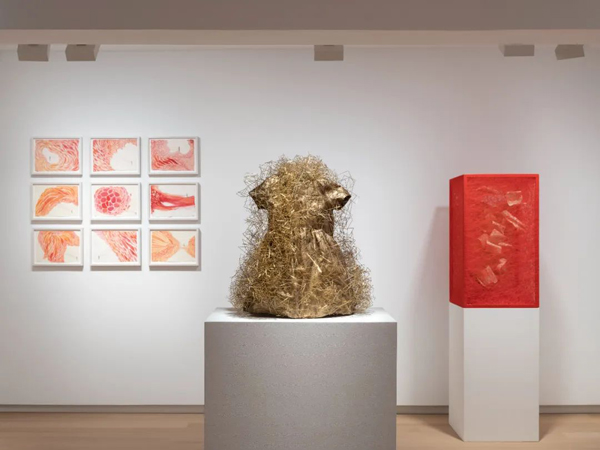
Installation shot of Signs of Life, Templon Gallery, New York. Photo: Charles Roussel. Courtesy of Templon Gallery and the artist
After being diagnosed with ovarian cancer, Shiota picked up the brush again and abandoned focusing on technical expression. Among the series of drawings on paper on display, Connecting the Universe (2022-2023) is a record of personal feelings, like a private diary, which, while not as powerful as an immersive installation, serves as another portal into Shiota’s inner world. The red yarn threads here represent communication, interaction, and connection between the inner and outer universes. And in the Endless Line (2022), the red yarn threads act as lines under the brush, producing a flat network diagram. With Shiota’s emphasis on the characteristics of privatization, the image becomes a neuron under a microscope, implying emotions converged in memory such as fear, anxiety, and sorrow.
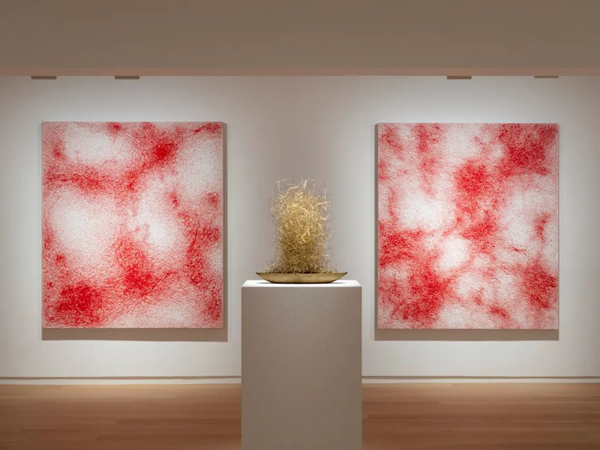
Installation shot of Signs of Life, Templon Gallery, New York. Photo: Charles Roussel. Courtesy of Templon Gallery and the artist
The brass wires used in small sculptures can be considered another type of “line,” which has different attributes and properties from soft threads. As they intertwine repeatedly, they obscure their traces and shape the “intangible” concept. The arm, boat, and dress, which are all cast in bronze, are visible material symbols. However, the brass wires signify eternity after extinction. State of Being (2022) is reminiscent of her large-scale installation Uncertain Journey (2019). In the previous work, the hull is solid, cast from bronze, with brass wires gradually piling up into a small mountain; in the latter, the metal frame constructs the simple boat shape, from which red yarn threads rise from it and cover the whole space above the gallery. From a spatial perspective, they complete the connection from the earth to the sky. It is as if there is a form of communication similar to that between the ancients and the sky, as well as contemplation of life and the cosmos. The human being himself, in all of his pursuits, is a part of the universe as well.
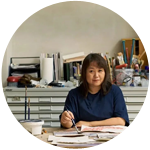
Born in Osaka, Japan, in 1972, Chiharu Shiota has been living and working in Berlin since 1999. Her work has been the subject of numerous solo exhibitions including: in 2018 at the Museum of Kyoto (Japan), Gothenburg Museum of Art, Gothenburg (Sweden), Art Gallery of South Australia, Adelaide (Australia) and Le Bon Marché, Paris (France); in 2019 at Gropius Bau, Berlin (Germany) and Mori Art Museum, Tokyo (Japan), and in 2020 at Fondazione Merz (Italy), Musia, Rome (Italy), and Muzeum ?l?skie w Katowicach (Poland). In 2021 her work was also shown at the 13th Gwangju Biennale Foundation in South Korea and the group exhibition STILL ALIVE, Werke aus der Shenkung Sammlung Hoffmann at Albertinum (Germany), Centro Cultural Banco do Brasil, Rio de Janeiro (Brazil), Zentrum für Kunst und Medien, Karsruhe (Germany), Museum of New Zealand Te Papa Tongarewa, Wellington (New Zealand), Towada Art Center, Aomori (Japan), Domaine de Chaumont-sur-Loire (France), Kenj Taki Gallery, Nagoya (Japan), and Tapei Fine Arts Museum (Taiwan). In 2022, her work has been shown at the Aichi Arts Center in Japan, Manifesta 14, Kosovo, Musée National des Arts Asiatiques-Guimet, Paris and Planta Project, Complejo Industrial La Plana del Corb, Balaguer, Lleida, Spain. The Schauwerk Sindelfingen in Germany is also showing a solo exhibition of her work until 8 October 2023.


